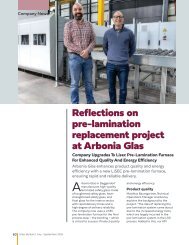Precautions and safety in handling glass
Ensuring Safety Amid Fragility: Guidelines for Handling, Storing, and Transporting Glass It is necessary to pay meticulous attention while handling glass to avoid accidents and injuries.
Ensuring Safety Amid Fragility: Guidelines for Handling, Storing, and Transporting Glass
It is necessary to pay meticulous attention while handling glass to avoid accidents and injuries.
You also want an ePaper? Increase the reach of your titles
YUMPU automatically turns print PDFs into web optimized ePapers that Google loves.
Technical Article<br />
<strong>Precautions</strong> <strong>and</strong> <strong>safety</strong><br />
<strong>in</strong> h<strong>and</strong>l<strong>in</strong>g <strong>glass</strong><br />
Ensur<strong>in</strong>g Safety Amid Fragility: Guidel<strong>in</strong>es for<br />
H<strong>and</strong>l<strong>in</strong>g, Stor<strong>in</strong>g, <strong>and</strong> Transport<strong>in</strong>g Glass<br />
It is necessary to pay meticulous attention while<br />
h<strong>and</strong>l<strong>in</strong>g <strong>glass</strong> to avoid accidents <strong>and</strong> <strong>in</strong>juries.<br />
Glass is fragile <strong>and</strong> brittle by<br />
nature. These properties<br />
require a special attention<br />
when load<strong>in</strong>g /un-load<strong>in</strong>g, stack<strong>in</strong>g,<br />
storage <strong>and</strong> transportation of <strong>glass</strong>.<br />
Mish<strong>and</strong>l<strong>in</strong>g can result <strong>in</strong><br />
accidents which can cause cut, <strong>in</strong>jury,<br />
amputation <strong>and</strong> even be fatal at<br />
times.<br />
HANDLING OF GLASS<br />
Need of <strong>safety</strong> <strong>in</strong> proper h<strong>and</strong>l<strong>in</strong>g<br />
of <strong>glass</strong> is of prime importance. The<br />
<strong>safety</strong> measures must be put <strong>in</strong> place<br />
<strong>and</strong> rigidly followed when h<strong>and</strong>l<strong>in</strong>g<br />
<strong>glass</strong>, both <strong>in</strong> small <strong>and</strong> large volumes.<br />
Over the time, by experience, certa<strong>in</strong><br />
procedures have been adhered to by<br />
<strong>glass</strong> factories <strong>and</strong> fabricators. Some<br />
of the most pert<strong>in</strong>ent <strong>safety</strong> practices<br />
required are:-<br />
1. Wear<strong>in</strong>g of cut resistant gloves<br />
<strong>and</strong> not lift<strong>in</strong>g the <strong>glass</strong> by bare h<strong>and</strong>s.<br />
2. The <strong>glass</strong> must be lifted by two<br />
persons;, s<strong>in</strong>gle person h<strong>and</strong>l<strong>in</strong>g of<br />
large size or heavy <strong>glass</strong> must be<br />
avoided. S<strong>in</strong>gle person h<strong>and</strong>l<strong>in</strong>g can<br />
result <strong>in</strong> twist<strong>in</strong>g <strong>and</strong> tipp<strong>in</strong>g of <strong>glass</strong>.<br />
3. Never lift a <strong>glass</strong> with bare toe or<br />
while wear<strong>in</strong>g slippers. Always wear<br />
tight boots. Fall<strong>in</strong>g of <strong>glass</strong> on the feet<br />
is most common. Also broken <strong>glass</strong> on<br />
the floor can get <strong>in</strong> to your feet.<br />
4. Use of vacuum grippers should<br />
be practiced. Use s<strong>in</strong>gle pad grippers<br />
for small size <strong>glass</strong>, <strong>and</strong> double or<br />
triple pad vacuum grippers for large<br />
size <strong>glass</strong>. Always use vacuum grippers<br />
<strong>in</strong> pairs.<br />
5. The <strong>glass</strong> should be clean <strong>and</strong> dry<br />
before lift<strong>in</strong>g. Wet <strong>glass</strong> can slip easily<br />
<strong>and</strong> also the vacuum griper will not<br />
grip the wet <strong>glass</strong> firmly.<br />
6. The lift<strong>in</strong>g capacity of a person<br />
must be kept <strong>in</strong> m<strong>in</strong>d. Lift<strong>in</strong>g <strong>glass</strong><br />
heavier than the capacity or for longer<br />
duration can pose a big problem of<br />
fatigue, result<strong>in</strong>g <strong>in</strong> slippage.<br />
7. All lift<strong>in</strong>g tools like sl<strong>in</strong>gs, vacuum<br />
pads, straps, hooks should have a<br />
<strong>safety</strong> factor of 2-2.5 .Only the properly<br />
tested <strong>and</strong> <strong>in</strong>spected equipment<br />
should be used.<br />
8. Worn out, cracked, broken <strong>safety</strong><br />
equipment, is a serious threat. It<br />
should never be used to h<strong>and</strong>le <strong>glass</strong>.<br />
9. Ensure that the path to the<br />
h<strong>and</strong>l<strong>in</strong>g area is clean; dry (no water<br />
or oil spillage) is there. This can be a<br />
major hazard <strong>and</strong> cause of mishap.<br />
10. Always wear the proper<br />
Personal Protection Equipment (PPE)<br />
like gloves, arm guards, <strong>safety</strong> <strong>glass</strong>es,<br />
boots, helmet, reflective uniform. Do<br />
not wear loose clothes to reduce risk<br />
of <strong>in</strong>jury.<br />
A very important say<strong>in</strong>g <strong>in</strong> <strong>glass</strong> <strong>in</strong>dustry is<br />
“NEVER TRY TO HOLD A FALLING GLASS, BETER<br />
TO RUN OR JUMP AWAY FROM THE GLASS”.<br />
The weight of the fall<strong>in</strong>g <strong>glass</strong> is 5 times the<br />
actual weight of the <strong>glass</strong>.<br />
Storage of Glass<br />
Storage of <strong>glass</strong> is required by all<br />
<strong>glass</strong> manufactures, fabricators,<br />
processors, resellers <strong>in</strong>clud<strong>in</strong>g small<br />
shopkeepers. Storage of <strong>glass</strong> is a<br />
very specialised work <strong>and</strong> should be<br />
done by tra<strong>in</strong>ed persons who should<br />
be aware of the risk of personal <strong>in</strong>jury<br />
<strong>and</strong> monetary loss <strong>in</strong> h<strong>and</strong>l<strong>in</strong>g flat<br />
<strong>glass</strong>. Underst<strong>and</strong><strong>in</strong>g of accident<br />
prone areas like stairs, sharp turns &<br />
corners, <strong>and</strong> tak<strong>in</strong>g effective steps,<br />
precautions will m<strong>in</strong>imise or elim<strong>in</strong>ate<br />
the accidents.<br />
Most important & foremost th<strong>in</strong>g<br />
<strong>in</strong> storage is RACKING. RACKING<br />
is stack<strong>in</strong>g of <strong>glass</strong> at an angle of<br />
<strong>in</strong>cl<strong>in</strong>ation also known as Lean Angle.<br />
The optimum angle of lean should be<br />
between 3-5 degrees. The storage can<br />
also be done aga<strong>in</strong>st a wall. The load<br />
bear<strong>in</strong>g capacity of the wall should be<br />
taken <strong>in</strong>to consideration. The floor on<br />
which the <strong>glass</strong> is be<strong>in</strong>g stored should<br />
be levelled <strong>and</strong> even. Uneven floor<br />
can result <strong>in</strong> fall<strong>in</strong>g <strong>and</strong> slipp<strong>in</strong>g of<br />
<strong>glass</strong>. The floor should also be strong<br />
enough to take the load of the <strong>glass</strong>.<br />
If the floor is not cemented or pacca,<br />
there can be chances that the floor<br />
might s<strong>in</strong>k with weight. Rodents etc.<br />
also are a threat <strong>in</strong> such a case.<br />
Dos <strong>and</strong> Don’ts of <strong>glass</strong> storage are:<br />
1. Never drag or slide the <strong>glass</strong><br />
across the ground. The best way is to<br />
lift <strong>and</strong> place the <strong>glass</strong>.<br />
2. The <strong>glass</strong> should be placed<br />
aga<strong>in</strong>st each other softly. Impact on<br />
one sheet from another can break the<br />
<strong>glass</strong>.<br />
3. Use of plastic corners, foam /cork<br />
separators will ease out plac<strong>in</strong>g <strong>and</strong><br />
removal of <strong>glass</strong> sheets.<br />
4. Use of various k<strong>in</strong>ds of lifters<br />
(Manual, Electric, Pneumatic,<br />
Hydraulic), EOT cranes, <strong>and</strong> Fork lifts<br />
should be encouraged to lift <strong>and</strong> stack<br />
the <strong>glass</strong> sheets.<br />
<strong>Precautions</strong> required dur<strong>in</strong>g storage<br />
of <strong>glass</strong> are:<br />
1. Ensure that the <strong>glass</strong> is properly<br />
secured <strong>and</strong> strapped before lift<strong>in</strong>g.<br />
Use of extra sl<strong>in</strong>gs, steel straps,<br />
<strong>and</strong> side sl<strong>in</strong>gs are an added <strong>safety</strong><br />
features but a must.<br />
2. Never move or st<strong>and</strong> <strong>in</strong> front of<br />
the fork lift. Keep the <strong>glass</strong> strapped<br />
to the back of the fork lift to avoid it<br />
from fall<strong>in</strong>g flat to the front.<br />
3. Capacity of EOT crane, Fork lift,<br />
Vacuum gripers, lift<strong>in</strong>g equipment<br />
should be kept <strong>in</strong> m<strong>in</strong>d. Never ever<br />
overload. Periodic check-up of all the<br />
lift<strong>in</strong>g equipment <strong>and</strong> ma<strong>in</strong>tenance<br />
should be done to avoid any mishap.<br />
90 Glass Bullet<strong>in</strong> | April - June, 2024
Techno Trade L<strong>in</strong>ks • 2<br />
4. Dur<strong>in</strong>g storage look for defects,<br />
cracks, chipped corners <strong>in</strong> the <strong>glass</strong>,<br />
if noticed do not store such <strong>glass</strong>. The<br />
flawed <strong>glass</strong> can break or cause <strong>in</strong>jury<br />
dur<strong>in</strong>g stack<strong>in</strong>g <strong>and</strong> removal.<br />
5. Storage area should be well<br />
lit <strong>and</strong> well ventilated. Foul smell,<br />
sneez<strong>in</strong>g, nausea can also be the<br />
cause of slippage of <strong>glass</strong> when<br />
manual stack<strong>in</strong>g. Large size <strong>glass</strong>es<br />
can obstruct the light <strong>and</strong> can create<br />
dark spots, which can be risky area of<br />
accidents.<br />
6. ‘A’ Frames are commonly used to<br />
stack the <strong>glass</strong>. It is advisable to stack<br />
the <strong>glass</strong> on both sides of ‘A’ Frame to<br />
make it stable <strong>and</strong> not tumble <strong>and</strong> tilt<br />
due to imbalance.<br />
7. Always ensure that the storage<br />
place is clean, it is not cluttered <strong>and</strong><br />
the path is free for movement. Any<br />
obstruction can be the reason for<br />
tumbl<strong>in</strong>g <strong>and</strong> tripp<strong>in</strong>g over.<br />
8. No pets <strong>in</strong> the storage area. Pets<br />
can hurt themselves <strong>and</strong> cause panic<br />
result<strong>in</strong>g <strong>in</strong> accidents.<br />
9. Noise is also a big problem<br />
<strong>in</strong> <strong>glass</strong> <strong>in</strong>dustry. Some mach<strong>in</strong>es<br />
like belt gr<strong>in</strong>ders, Edge gr<strong>in</strong>ders,<br />
<strong>and</strong> toughened <strong>glass</strong> plant create a<br />
lot of noise. This noise can make it<br />
difficult to hear the <strong>in</strong>structions <strong>and</strong><br />
movement of storage vehicles, which<br />
could result <strong>in</strong>to collision <strong>and</strong> mishap.<br />
Avoid storage <strong>in</strong> noisy area.<br />
10. The walk way for workers, area<br />
for movement of vehicles, trolleys<br />
etc. should be away from storage<br />
area. These areas should be clearly<br />
designated <strong>and</strong> marked. The storage<br />
area should be cordoned <strong>and</strong> fenced<br />
for <strong>safety</strong> reasons.<br />
11. Safety <strong>in</strong>structions, dos <strong>and</strong><br />
don’ts chart, caution notices must be<br />
prom<strong>in</strong>ently displayed. The tra<strong>in</strong><strong>in</strong>g<br />
of storage area workers must be a<br />
regular feature. This will keep them<br />
updated <strong>and</strong> aware of the risks.<br />
12. If any shift or slip or untoward<br />
th<strong>in</strong>g is noticed <strong>in</strong> stack, the area must<br />
be earmarked as out of bounds. The<br />
problem must be attended to on top<br />
priority, without any delay.<br />
Transportation of Glass<br />
Transportation of any fragile good is a<br />
challenge <strong>in</strong> itself. When transport<strong>in</strong>g<br />
<strong>glass</strong> lot of care, precautions <strong>and</strong><br />
alertness is required. Break<strong>in</strong>g,<br />
scratch<strong>in</strong>g, chipp<strong>in</strong>g, corner break<strong>in</strong>g<br />
dur<strong>in</strong>g load<strong>in</strong>g/ unload<strong>in</strong>g are very<br />
common. The risk of <strong>in</strong>jury <strong>and</strong> gett<strong>in</strong>g<br />
hurt or bruised is very high dur<strong>in</strong>g<br />
load<strong>in</strong>g/ unload<strong>in</strong>g of <strong>glass</strong> on truck or<br />
conta<strong>in</strong>er.<br />
When load<strong>in</strong>g on truck/ any vehicle<br />
or conta<strong>in</strong>er, the ma<strong>in</strong> problem is the<br />
constra<strong>in</strong>t of area. The movement<br />
is much restricted due to area<br />
availability that result <strong>in</strong> bruises <strong>and</strong><br />
cuts very often. Sever<strong>in</strong>g of f<strong>in</strong>gers is<br />
another serious issue.<br />
It is always better to use<br />
mechanical equipment like cranes,<br />
hoists <strong>and</strong> other manual lift<strong>in</strong>g<br />
devises such as cha<strong>in</strong> pulley blocks,<br />
hoists, tripods to m<strong>in</strong>imise human<br />
<strong>in</strong>teraction. Many a times the trucks<br />
are loaded <strong>in</strong> a pit, which makes it<br />
easier <strong>and</strong> efficient.<br />
<strong>Precautions</strong> to be taken for<br />
transportation:<br />
1. The truck or conta<strong>in</strong>er should be<br />
loaded with even load distribution.<br />
2. The <strong>glass</strong> should be secured <strong>in</strong><br />
wooden crates with steel strapp<strong>in</strong>g.<br />
Corners of the <strong>glass</strong> should be<br />
secured with cardboard or plastic<br />
corner protectors.<br />
3. The <strong>glass</strong> loaded on the truck<br />
should be securely strapped, to<br />
avoid breakage due to bumps, pits or<br />
sudden break<strong>in</strong>g on the road.<br />
4. Foam, cork <strong>and</strong> other<br />
polyurethane separators are placed<br />
between the <strong>glass</strong> sheets, cover<strong>in</strong>g of<br />
<strong>glass</strong> by plastic film will help to take<br />
care of breakage <strong>and</strong> scratches due to<br />
friction dur<strong>in</strong>g transportation.<br />
5. The truck / conta<strong>in</strong>er should not<br />
be overloaded or driven at high speed.<br />
When turn<strong>in</strong>g it should be controlled<br />
<strong>and</strong> slow. Manoeuvr<strong>in</strong>g on sharp<br />
turns, high height speed breakers or<br />
multiple speed breakers should be<br />
done very carefully.<br />
6. Always lay the <strong>glass</strong> on the<br />
edge i.e., <strong>in</strong> upright position. The<br />
edge should be laid on soft wooden<br />
logs, with rubber <strong>and</strong> foam padd<strong>in</strong>g<br />
.This will avoid chipp<strong>in</strong>g at the<br />
edges. Horizontal stack<strong>in</strong>g is not<br />
recommended.<br />
7. ‘A’ frame is used to transport <strong>glass</strong><br />
on tempos <strong>and</strong> smaller vehicles. The<br />
‘A’ Frame should be strong enough to<br />
take the load. Both sides should be<br />
loaded evenly. The ‘A’ frame should<br />
be very rigidly secured to the floor of<br />
the vehicle. The ‘A’ frame should be<br />
levelled to avoid slippage of <strong>glass</strong>. The<br />
<strong>glass</strong> crates should be strapped with<br />
rubber sl<strong>in</strong>gs very securely.<br />
8. Climatic conditions also affect<br />
the transportation of <strong>glass</strong>. Extreme<br />
heat or cold can cause thermal shock<br />
<strong>in</strong> the <strong>glass</strong>. Ra<strong>in</strong> water, dust can also<br />
damage the <strong>glass</strong>. The <strong>glass</strong> sheets<br />
should be covered by plastic sheets<br />
before putt<strong>in</strong>g <strong>in</strong> the crate.<br />
9. Unload<strong>in</strong>g is equally important.<br />
Lot of caution <strong>and</strong> care is desired<br />
while open<strong>in</strong>g the crates. The open<strong>in</strong>g<br />
of crates should be done slowly,<br />
10. Never st<strong>and</strong> <strong>in</strong> front of the <strong>glass</strong><br />
while open<strong>in</strong>g the crate. Avoid us<strong>in</strong>g<br />
sharp metal objects with <strong>glass</strong> as it<br />
may break the <strong>glass</strong>. One sheet at a<br />
time should be lifted. The next sheet<br />
must be secured before remov<strong>in</strong>g the<br />
front sheet.<br />
All this <strong>and</strong> many more precautions<br />
are required to h<strong>and</strong>le <strong>and</strong> m<strong>in</strong>imise<br />
the breakage of <strong>glass</strong> <strong>and</strong> <strong>in</strong>jury to the<br />
human be<strong>in</strong>gs.<br />
Have a safe h<strong>and</strong>l<strong>in</strong>g, storage <strong>and</strong><br />
transportation of <strong>glass</strong>. That is the<br />
purpose <strong>and</strong> aim of this article.<br />
The Author:<br />
MR. SUDHIR ARORA, B.Sc Engg. (Mech), LLB,<br />
Manag<strong>in</strong>g Director of Techno Trade L<strong>in</strong>ks<br />
Website: www.technotradel<strong>in</strong>ks.<strong>in</strong><br />
Glass Bullet<strong>in</strong> | April - June, 2024<br />
91

















